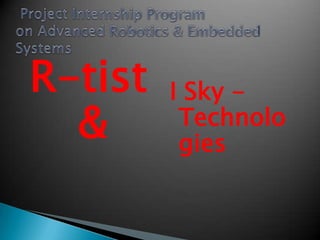
Day1
- 1. R-tist I Sky - & Technolo gies
- 4. Input Embeded Output system Devices Devices
- 5. It is an open source hardware. The arduino program done on arduino IDE board. Crystal oscillation is of 16 MHz follow the path of minimum error with acurate maxi. Efficiency. Microcontroller need only squar wave form that that is why we need capacitor with crystal oscillator. It also reduce noise.
- 6. Hardware Software The Arduino or The Arduino IDE. other clone boards Based on win AVR Based on the Atmel (C compiler for AVR AVR series Microcontrollers) Controllers
- 7. Swarms of robots are effective: ◦ They can perform tasks that one expensive robot cannot. Swarms are robust: ◦ Even if some robots fail, the swarm can still achieve the task.
- 8. Scenario: Unmanned Aerial Vehicles Cooperate To Detect Targets
- 9. Inter-Integrated Circuit( generically referred to as "two-wire interface“) is a multi- master serial single-ended computer bus invented by Philips that is used to attach low-speed peripherals to a motherboard, embedded system, or cellphone or other electronics. I²C uses only two bidirectional open-drain lines, Serial Data Line (SDA) and Serial Clock (SCL), pulled up with resistors. Typical voltages used are +5 V or +3.3 V although systems with other voltages are permitted.
- 10. The interintegrated circuit (I 2 C) bus is designed for short-range communication between chips in the same system using a software addressing system. It requires only two signal wires and operates like a simplified local area network. The I 2 C slave chips are attached to a two-wire bus, which is pulled up to logic 1 when idle. Passive slave devices have their register or location addresses determined by a combination of external input address code pins and fixed internal decoding. If several memory devices are connected to the bus, they can be mapped into a continuous address space. The master sends data in 8-bit blocks, with a synchronous clock pulse alongside each bit. As for SPI, the clock is derived from the instruction clock, up to 5 MHz at the maximum clock rate of 20 MHz. To send a data byte, the master first sends a control code to set up the transfer, then the 8-bit or 10-bit address code, and finally the data. Each byte has a start and acknowledge bit, and each byte must be acknowledged before the next is sent, to improve reliability.
- 11. master Slave 1 Slave 2 5 volt scl sda
- 13. How to use arduino IDE Select Board Tool Select serial port
- 14. cotrol panel -> device manager -> unknown serial port->right click on unknown serial port->update dreiver from computer -> Give the path of pin drive then next-> see your port no is showing or not if not repeat the process.
- 18. Q-: Make a program using pin D11, D12 and D13 blink LED in the manner of aeroplane light you see in night.
- 19. int sen1=11; digitalWrite(12, HIGH); int sen2=12; digitalWrite(13, LOW); int sen13=13; digitalWrite(11,LOW); delay(1000); void setup() { digitalWrite(11, LOW); // initialize the digital pin as an digitalWrite(12, LOW); output. digitalWrite(13, HIGH); // Pin 13 has an LED connected on delay(1000); most Arduino boards: digitalWrite(11, HIGH); pinMode(11, OUTPUT); digitalWrite(12, HIGH); pinMode(12, OUTPUT); digitalWrite(13, HIGH); pinMode(13, OUTPUT); delay(1000); } digitalWrite(11, LOW); digitalWrite(12, LOW); void loop() { digitalWrite(13, LOW); digitalWrite(11, HIGH); delay(1000); digitalWrite(12, LOW); digitalWrite(13, LOW); delay(1000); }
- 20. Make a program using bit D11,D12 and D13 to show binary counting by blinking led.
